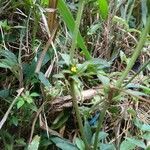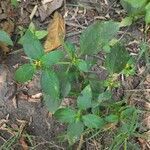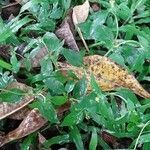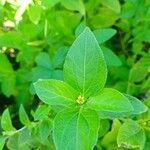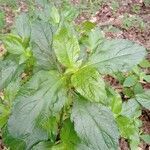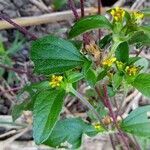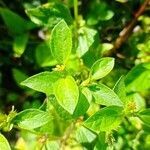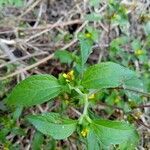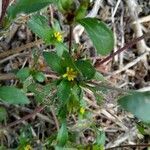Annuals, 10-80 cm tall. Stems erect or ascending, branched from bases or ± throughout. Leaves cauline, opposite, petiolate; blade ovate to elliptic, 3-10 × 2-5 cm, both surfaces ± scabrid, usually 3-veined, base cuneate to rounded, margin toothed. Capitula radiate, sessile or subsessile in axillary glomerules or capitula solitary; involucres cylindric to campanulate, 3-6 mm in diam.; phyllaries persistent, 2-5+, 1(or 2)-seriate, lanceolate, herbaceous to papery; receptacle convex; paleae linear-lanceolate, scarious, flat or weakly cupped at bases. Ray florets 2-9, 1-or 2-seriate, female, fertile; corollas yellowish, ca. 2 mm; lamina ovate to linear, 2-4 mm. Disk florets 4-12+, bisexual, fertile; corollas yellowish, tubes ca. 4 mm, ± equaling slightly enlarged cylindric throats, 4-lobed, orbicular-deltate. Fl. year-round. 2n = 40.
Annual herb, erect, 15–120 cm high, hardly branched to much branched, the stems scabridulous but glabrescent.. Leaves ovate or elliptic, 2–12 cm long, 1–5 cm wide, base cuneate and decurrent, margins crenulate-serrate or rarely subentire, apex acute or obtuse, 3-veined from base, scabridulous on both surfaces; petiole winged, to 3 cm long.. Capitula axillary and terminal, in dense sessile glomerules; involucre 7–12 mm long; outer phyllaries green, the inner phyllaries scarious; paleae with eroded or ciliate margins.. Ray florets 3–8, yellow, the ray 1.5–3 mm long; disc florets 4–11, yellow, 2–4 mm long.. Achenes of ray florets 4–5 mm long, winged, with 2 short awns; achenes of disc florets 4–6 mm long, the outer winged, the inner without wings, pappus of 2–3 awns 2–4.5 mm long.. Fig. 157 (page 745).
Erect herb to (0.15–) 0.3–1 (–2) m high. Stems rounded, with white antrorse appressed hairs. Leaves (2.7–) 4–11 (–14) cm long, (1.2–) 2–6 (–8) cm wide, discolorous, scabrous with sparse antrorse, appressed, white strigose hairs. Capitula c. 10 mm in length, in loose or dense dichasial clusters at nodes, or solitary on naked peduncles 1–25 mm long; outer involucral bracts 9–10 mm long; inner bracts 7–8 mm long; receptacle slightly domed. Ray florets 3–8; ligulate; ligule c. 4 mm long, 2-or 3-lobed. Ray achenes 5–6 mm in length including pappus, grey with cream margins. Disc achenes 4–5 mm long excluding pappus, dark grey to black, with 2 longitudinal ribs on abaxial face, 2 longitudinal ribs and lines of small tubercles on adaxial face; pappus awns 2, 2–4 mm long, rarely a smaller third awn.
An annual herb. It has erect stems. It grows to 70 cm-2 m tall. The branches usually divided into two at each branch. The leaves are produced opposite each other and are 10 cm long on slender winged leaf stalks. It has an unpleasant smell. The flowers are yellow. They are in small heads. They can be singly or several together. They are in the axils of leaves. The fruit are flat and 4.5 mm long by 2 mm wide. They have stiff fringed wings.
Leaf blades 3–10 × 2–5 cm. Ray corollas: tubes ca. 2 mm, laminae narrowly ovate to linear, 2–4 mm. Disc corollas ca. 3 mm. Cypselae ca. 4 mm. 2n = 36, 38, 40.
